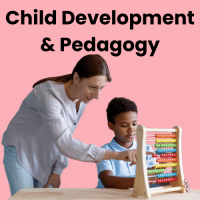CTET & State TET Exam > CTET & State TET Questions > explanation is not hindi i want english Rela...
Start Learning for Free
explanation is not hindi i want english
?Most Upvoted Answer
explanation is not hindi i want english Related: Vygotsky Theory - C...
Vygotsky Theory - Child Development and Pedagogy for CTET Exams
Vygotsky's theory of child development, also known as sociocultural theory, emphasizes the role of social interaction and cultural factors in cognitive development. This theory was developed by the Russian psychologist Lev Vygotsky in the early 20th century and has had a significant impact on the field of education.
According to Vygotsky, children's cognitive development is influenced by their social interactions with more knowledgeable individuals, such as parents, teachers, and peers. He believed that learning takes place within the "zone of proximal development," which refers to the gap between a child's current level of understanding and their potential level of understanding with the help of a more knowledgeable person.
Key Concepts of Vygotsky's Theory:
1. Zone of Proximal Development (ZPD): This refers to the range of tasks that a child can perform with assistance from a more skilled individual. Vygotsky argued that learning occurs most effectively within this zone, as it allows the child to gradually acquire new skills and knowledge.
2. Scaffolding: Scaffolding is the process of providing temporary support to a child as they learn a new task or concept. This support can take various forms, such as verbal instructions, prompts, or demonstrations. The goal of scaffolding is to gradually reduce the support as the child becomes more capable of performing the task independently.
3. More Knowledgeable Other (MKO): The MKO refers to a person who has a higher level of knowledge or expertise than the learner. This could be a parent, teacher, or peer. The MKO plays a crucial role in guiding and supporting the child's learning process.
4. Cultural Tools: Vygotsky emphasized the importance of cultural tools, such as language, symbols, and technology, in cognitive development. These tools are passed on to children through social interactions and help shape their thinking and problem-solving abilities.
Implications for Pedagogy:
Vygotsky's theory has several implications for pedagogy, or the practice of teaching. Some of these include:
1. Collaborative Learning: Vygotsky believed that learning is a social process and that children benefit from working together with their peers. Collaborative learning activities, such as group projects or discussions, can help promote higher-level thinking and problem-solving skills.
2. Scaffolding and Assistance: Teachers can provide scaffolding and assistance to help students navigate their zone of proximal development. This can involve breaking down complex tasks into smaller, more manageable steps, providing clear instructions and feedback, and offering support when needed.
3. Use of Cultural Tools: Teachers can incorporate cultural tools, such as language, visuals, and technology, into their lessons to enhance students' understanding and engagement. This can include using visual aids, interactive activities, and multimedia resources.
4. Assessment and Feedback: Vygotsky's theory suggests that assessment should focus on a student's potential level of understanding rather than just their current level. Teachers can use formative assessments to identify students' zone of proximal development and provide targeted feedback to help them progress.
Overall, Vygotsky's theory highlights the importance of social interaction, scaffolding, and cultural tools in promoting children's cognitive development. By understanding and applying these concepts in the classroom, educators can create a supportive and engaging learning environment for their students.
Vygotsky's theory of child development, also known as sociocultural theory, emphasizes the role of social interaction and cultural factors in cognitive development. This theory was developed by the Russian psychologist Lev Vygotsky in the early 20th century and has had a significant impact on the field of education.
According to Vygotsky, children's cognitive development is influenced by their social interactions with more knowledgeable individuals, such as parents, teachers, and peers. He believed that learning takes place within the "zone of proximal development," which refers to the gap between a child's current level of understanding and their potential level of understanding with the help of a more knowledgeable person.
Key Concepts of Vygotsky's Theory:
1. Zone of Proximal Development (ZPD): This refers to the range of tasks that a child can perform with assistance from a more skilled individual. Vygotsky argued that learning occurs most effectively within this zone, as it allows the child to gradually acquire new skills and knowledge.
2. Scaffolding: Scaffolding is the process of providing temporary support to a child as they learn a new task or concept. This support can take various forms, such as verbal instructions, prompts, or demonstrations. The goal of scaffolding is to gradually reduce the support as the child becomes more capable of performing the task independently.
3. More Knowledgeable Other (MKO): The MKO refers to a person who has a higher level of knowledge or expertise than the learner. This could be a parent, teacher, or peer. The MKO plays a crucial role in guiding and supporting the child's learning process.
4. Cultural Tools: Vygotsky emphasized the importance of cultural tools, such as language, symbols, and technology, in cognitive development. These tools are passed on to children through social interactions and help shape their thinking and problem-solving abilities.
Implications for Pedagogy:
Vygotsky's theory has several implications for pedagogy, or the practice of teaching. Some of these include:
1. Collaborative Learning: Vygotsky believed that learning is a social process and that children benefit from working together with their peers. Collaborative learning activities, such as group projects or discussions, can help promote higher-level thinking and problem-solving skills.
2. Scaffolding and Assistance: Teachers can provide scaffolding and assistance to help students navigate their zone of proximal development. This can involve breaking down complex tasks into smaller, more manageable steps, providing clear instructions and feedback, and offering support when needed.
3. Use of Cultural Tools: Teachers can incorporate cultural tools, such as language, visuals, and technology, into their lessons to enhance students' understanding and engagement. This can include using visual aids, interactive activities, and multimedia resources.
4. Assessment and Feedback: Vygotsky's theory suggests that assessment should focus on a student's potential level of understanding rather than just their current level. Teachers can use formative assessments to identify students' zone of proximal development and provide targeted feedback to help them progress.
Overall, Vygotsky's theory highlights the importance of social interaction, scaffolding, and cultural tools in promoting children's cognitive development. By understanding and applying these concepts in the classroom, educators can create a supportive and engaging learning environment for their students.
Attention CTET & State TET Students!
To make sure you are not studying endlessly, EduRev has designed CTET & State TET study material, with Structured Courses, Videos, & Test Series. Plus get personalized analysis, doubt solving and improvement plans to achieve a great score in CTET & State TET.

|
Explore Courses for CTET & State TET exam
|

|
Similar CTET & State TET Doubts
explanation is not hindi i want english Related: Vygotsky Theory - Child Development and Pedagogy for CTET Exams?
Question Description
explanation is not hindi i want english Related: Vygotsky Theory - Child Development and Pedagogy for CTET Exams? for CTET & State TET 2024 is part of CTET & State TET preparation. The Question and answers have been prepared according to the CTET & State TET exam syllabus. Information about explanation is not hindi i want english Related: Vygotsky Theory - Child Development and Pedagogy for CTET Exams? covers all topics & solutions for CTET & State TET 2024 Exam. Find important definitions, questions, meanings, examples, exercises and tests below for explanation is not hindi i want english Related: Vygotsky Theory - Child Development and Pedagogy for CTET Exams?.
explanation is not hindi i want english Related: Vygotsky Theory - Child Development and Pedagogy for CTET Exams? for CTET & State TET 2024 is part of CTET & State TET preparation. The Question and answers have been prepared according to the CTET & State TET exam syllabus. Information about explanation is not hindi i want english Related: Vygotsky Theory - Child Development and Pedagogy for CTET Exams? covers all topics & solutions for CTET & State TET 2024 Exam. Find important definitions, questions, meanings, examples, exercises and tests below for explanation is not hindi i want english Related: Vygotsky Theory - Child Development and Pedagogy for CTET Exams?.
Solutions for explanation is not hindi i want english Related: Vygotsky Theory - Child Development and Pedagogy for CTET Exams? in English & in Hindi are available as part of our courses for CTET & State TET.
Download more important topics, notes, lectures and mock test series for CTET & State TET Exam by signing up for free.
Here you can find the meaning of explanation is not hindi i want english Related: Vygotsky Theory - Child Development and Pedagogy for CTET Exams? defined & explained in the simplest way possible. Besides giving the explanation of
explanation is not hindi i want english Related: Vygotsky Theory - Child Development and Pedagogy for CTET Exams?, a detailed solution for explanation is not hindi i want english Related: Vygotsky Theory - Child Development and Pedagogy for CTET Exams? has been provided alongside types of explanation is not hindi i want english Related: Vygotsky Theory - Child Development and Pedagogy for CTET Exams? theory, EduRev gives you an
ample number of questions to practice explanation is not hindi i want english Related: Vygotsky Theory - Child Development and Pedagogy for CTET Exams? tests, examples and also practice CTET & State TET tests.

|
Explore Courses for CTET & State TET exam
|

|
Suggested Free Tests
Signup for Free!
Signup to see your scores go up within 7 days! Learn & Practice with 1000+ FREE Notes, Videos & Tests.

























